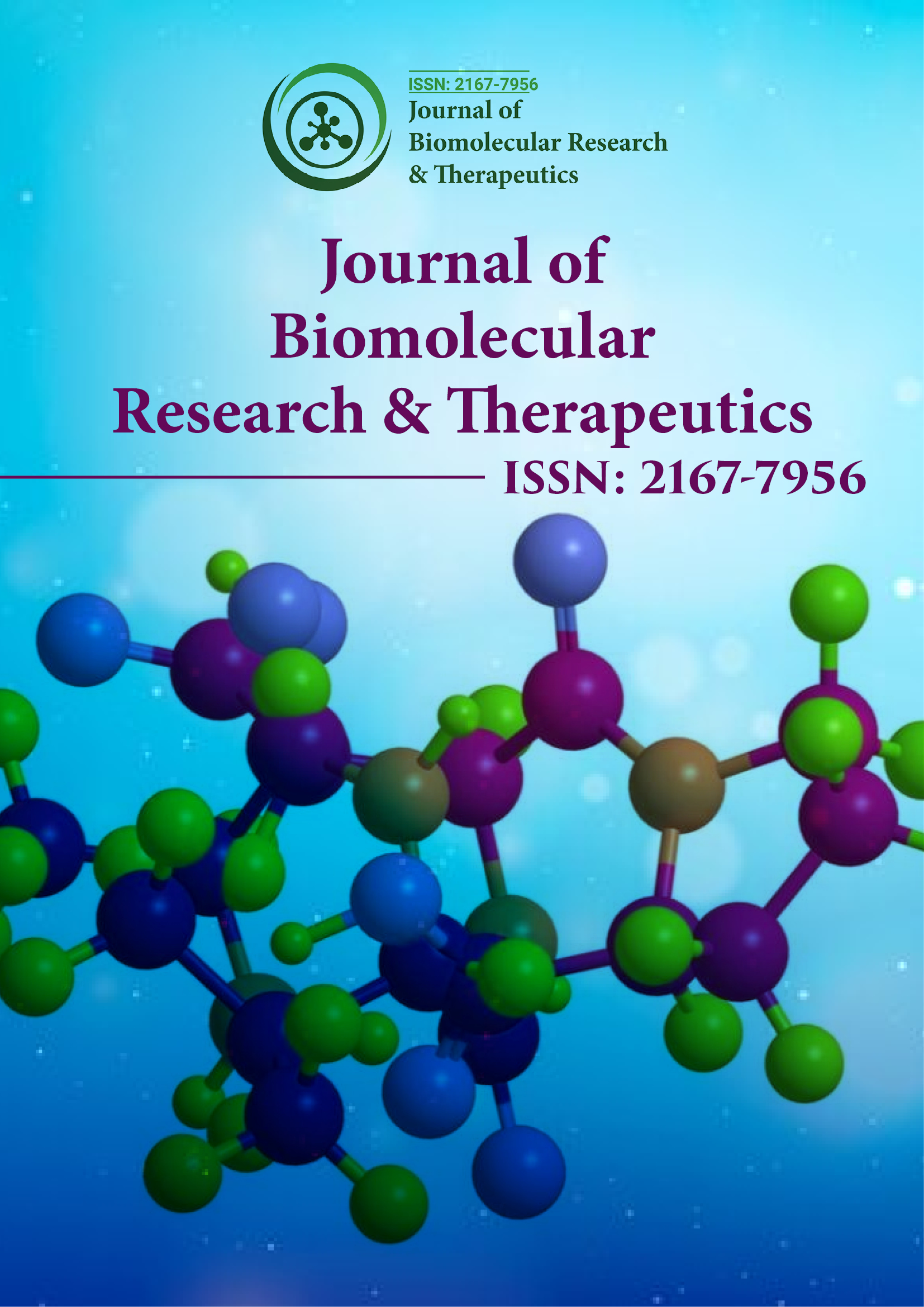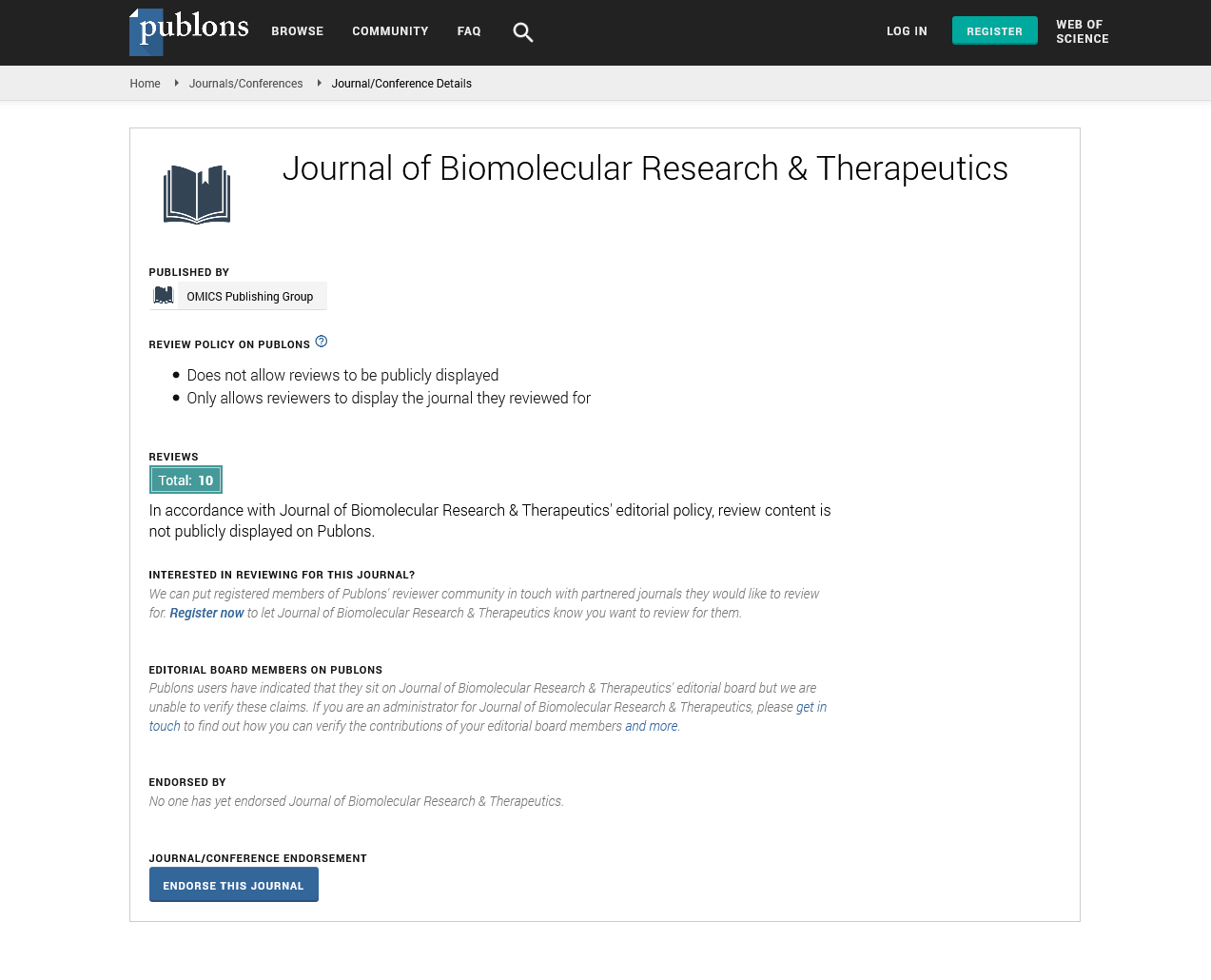Indexed In
- Open J Gate
- Genamics JournalSeek
- ResearchBible
- Electronic Journals Library
- RefSeek
- Hamdard University
- EBSCO A-Z
- OCLC- WorldCat
- SWB online catalog
- Virtual Library of Biology (vifabio)
- Publons
- Euro Pub
- Google Scholar
Useful Links
Share This Page
Journal Flyer

Open Access Journals
- Agri and Aquaculture
- Biochemistry
- Bioinformatics & Systems Biology
- Business & Management
- Chemistry
- Clinical Sciences
- Engineering
- Food & Nutrition
- General Science
- Genetics & Molecular Biology
- Immunology & Microbiology
- Medical Sciences
- Neuroscience & Psychology
- Nursing & Health Care
- Pharmaceutical Sciences
Short Communication - (2024) Volume 13, Issue 4
Organic Biomolecules in Health and Disease: Mechanisms and Therapeutic Potential
Hiranuma Tanaka*Received: 29-Jul-2024, Manuscript No. BOM-24-26555; Editor assigned: 01-Aug-2024, Pre QC No. BOM-24-26555 (PQ); Reviewed: 15-Aug-2024, QC No. BOM-24-26555; Revised: 22-Aug-2024, Manuscript No. BOM-24-26555 (R); Published: 30-Aug-2024, DOI: 10.35248/2167-7956.24.13.394
Description
Organic biomolecules, which include carbohydrates, lipids, proteins, and nucleic acids, play a major role in the maintenance of life processes. These molecules are integral to the structure and function of cells and tissues, mediating biochemical reactions and pathways essential for life. The interaction between these biomolecules governs health and disease states, making them critical targets for therapeutic interventions.
Carbohydrates
Carbohydrates, composed of carbon, hydrogen, and oxygen, are primary energy sources and structural components of cells. Simple sugars like glucose provide immediate energy, while complex carbohydrates like glycogen and cellulose serve as longterm energy stores and structural elements, respectively.
In health, carbohydrates are major for energy metabolism. The glycolytic pathway, Krebs cycle, and oxidative phosphorylation processes convert glucose into ATP, the energy currency of the cell. Disruptions in carbohydrate metabolism can lead to diseases like diabetes mellitus, characterized by high blood sugar levels due to insulin resistance or deficiency. Long-term complications of diabetes include cardiovascular diseases, neuropathy, retinopathy, and nephropathy.
Therapeutically, managing blood glucose levels is important for diabetic patients. Medications like metformin enhance insulin sensitivity, while insulin therapy directly supplements insulin levels. Additionally, lifestyle interventions such as diet and exercise are pivotal in maintaining healthy glucose metabolism [1,2].
Lipids
Lipids, including fats, oils, and phospholipids, are essential for storing energy, building cellular membranes, and signaling. They provide more energy than carbohydrates and proteins, making them efficient energy reserves. Phospholipids form the lipid bilayer of cell membranes, providing structural integrity and regulating the movement of substances in and out of cells.
In health, lipids are integral to cell membrane composition and function, hormone production, and intracellular signaling. Abnormal lipid metabolism can lead to diseases such as obesity, cardiovascular disease, and metabolic syndrome. For instance, atherosclerosis, the buildup of fatty deposits in arteries, can result in heart attacks and strokes [3,4].
Proteins
Proteins, composed of amino acids, are the fundamentals of the cell, performing a vast array of functions. They act as enzymes, catalyzing biochemical reactions; as structural components, providing support and shape to cells and tissues; and as signaling molecules, regulating physiological processes.
In health, proteins are essential for muscle contraction, immune responses, and hormone production. Abnormal protein function can lead to various diseases. For example, cystic fibrosis is caused by mutations in the CFTR protein, leading to impaired chloride ion transport and thick mucus production in the lungs and digestive tract. Another example is sickle cell disease, resulting from a mutation in the hemoglobin protein, causing red blood cells to assume a sickle shape and leading to anemia and vaso-occlusive crises [5,6].
Nucleic acids
Nucleic acids, DNA and RNA, store and transmit genetic information. DNA holds the blueprint for all cellular functions, while RNA translates and executes these instructions. The precise regulation of gene expression ensures proper cell function and adaptation to environmental changes.
In health, nucleic acids are fundamental for growth, development, and cellular repair. Mutations in DNA can lead to diseases such as cancer, where uncontrolled cell growth occurs due to oncogene activation or tumor suppressor gene inactivation. Additionally, genetic disorders like Huntington’s disease and muscular dystrophy arise from inherited DNA mutations [7].
Therapeutically, nucleic acid-based treatments are gaining prominence. Antisense oligonucleotides and small interfering RNAs can specifically target and degrade mutant mRNA, reducing the production of harmful proteins. CRISPR-Cas9 gene editing technology has potential for correcting genetic mutations at their source [8].
Interplay and therapeutic potential
The interaction between these biomolecules is critical for maintaining health. Dysregulation in one type can impact others, leading to complex disease mechanisms. For instance, insulin resistance in diabetes affects carbohydrate metabolism, leading to altered lipid and protein metabolism as well. Understanding these interactions is essential for developing comprehensive therapeutic strategies.
Emerging therapies aim to target these complex interactions. Systems biology approaches, integrating genomics, proteomics, and metabolomics, provide insights into the holistic functioning of biomolecules. Personalized medicine, tailoring treatments based on an individual's genetic and biochemical profile, is becoming increasingly feasible [9].
Biomolecules also offer therapeutic potential beyond treating diseases. In regenerative medicine, biomaterials derived from proteins and polysaccharides are used to engineer tissues and organs. For example, collagen and fibrin scaffolds support cell growth and tissue regeneration, offering solutions for wound healing and organ transplantation [10].
Conclusion
Organic biomolecules are central to the functioning of life, with their complex mechanisms underlying health and disease states. Understanding the roles and interactions of carbohydrates, lipids, proteins, and nucleic acids enables the development of targeted therapies and innovative treatments. As research advances, the therapeutic potential of organic biomolecules continues to expand, advanced for improved health outcomes and disease management.
References
- Rorsman P, Ashcroft FM. Pancreatic β-cell electrical activity and insulin secretion: Of mice and men. Physiol Rev. 2018;98(1):117-214.
[Crossref] [Google Scholar] [PubMed]
- Samuel VT, Shulman GI. Mechanisms for insulin resistance: Common threads and missing links. Cell. 2012;148(5):852-871.
- Nelson RH. Hyperlipidemia as a risk factor for cardiovascular disease. Prim Care. 2013;40(1):195-211.
[Crossref] [Google Scholar] [PubMed]
- Libby P. The changing landscape of atherosclerosis. Nature. 2021 Apr 22;592(7855):524-33.
[Crossref] [Google Scholar] [PubMed]
- Chroneos ZC, Wert SE, Livingston JL, Hassett DJ, Whitsett JA. Role of cystic fibrosis transmembrane conductance regulator in pulmonary clearance of Pseudomonas aeruginosa in vivo. The Journal of Immunology. 2000;165(7):3941-3950.
[Crossref] [Google Scholar] [PubMed]
- Steinberg MH, Sebastiani P. Genetic modifiers of sickle cell disease. Am J Hematol. 2012;87(8):795-803.
[Crossref] [Google Scholar] [PubMed]
- Friedmann T, Roblin R. Gene Therapy for Human Genetic Disease? Proposals for genetic manipulation in humans raise difficult scientific and ethical problems. Science. 1972;175(4025):949-955.
[Crossref] [Google Scholar] [PubMed]
- Gori JL, Hsu PD, Maeder ML, Shen S, Welstead GG, Bumcrot D. Delivery and specificity of CRISPR/Cas9 genome editing technologies for human gene therapy. Hum Gene Ther. 2015;26(7):443-451.
[Crossref] [Google Scholar] [PubMed]
- Hood L, Flores M. A personal view on systems medicine and the emergence of proactive P4 medicine: Predictive, preventive, personalized and participatory. N Biotechnol. 2012;29(6):613-624.
- Westerhoff HV, Palsson BO. The evolution of molecular biology into systems biology. Nat Biotechnol. 2004;22(10):1249-52.
[Crossref] [Google Scholar] [PubMed]
Citation: Tanaka H (2024). Organic Biomolecules in Health and Disease: Mechanisms and Therapeutic Potential. J Biomol Res Ther. 13:394.
Copyright: © 2024 Tanaka H. This is an open-access article distributed under the terms of the Creative Commons Attribution License, which permits unrestricted use, distribution, and reproduction in any medium, provided the original author and source are credited.

